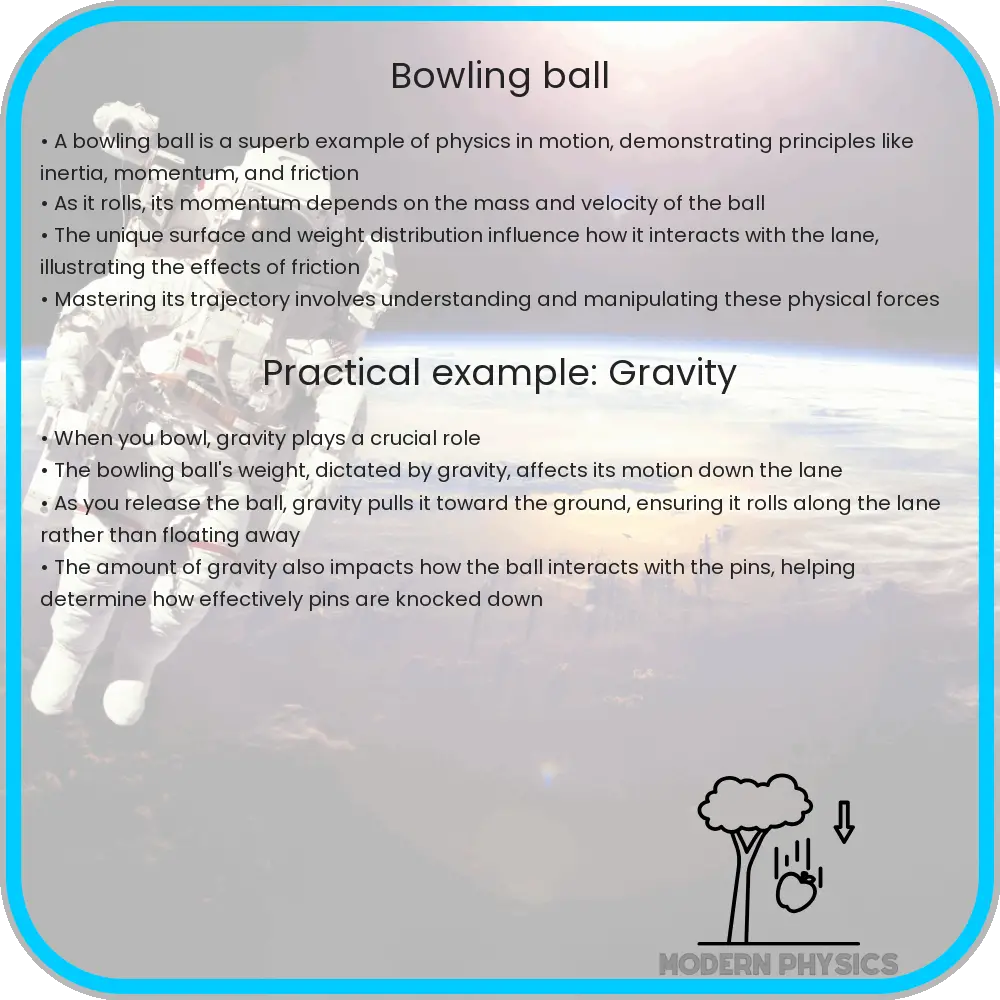Explore the physics of bowling with our in-depth guide covering kinematics, precision, dynamics, and the impact of ball design and lane conditions.

Understanding Bowling Ball Motion: A Deep Dive into Kinematics, Precision, and Dynamics
The physics of bowling involves a complex interplay of kinematics, precision, and dynamics. To truly appreciate what happens when a bowling ball is rolled down a lane, one must delve into the principles of physics that govern its motion. This article aims to unravel these principles, providing insight into the fascinating world of bowling ball dynamics.
Kinematics of Bowling Ball Motion
Kinematics, the branch of mechanics that describes the motion of objects, is central to understanding how a bowling ball moves. The motion of a bowling ball can be broken down into translational and rotational movements. Translational motion refers to the straight-line movement of the ball’s center of mass, while rotational motion pertains to the ball spinning on its axis.
- Velocity and Acceleration: The initial velocity of the ball as it leaves the bowler’s hand and its acceleration due to gravity and friction with the lane are key components of its translational motion.
- Angular Velocity: This is a measure of the rate of rotation of the ball. A higher angular velocity typically results in more pronounced hooking action.
Precision in Bowling Ball Release
The precision of the release greatly influences the ball’s trajectory. Factors such as the release angle, spin, and speed are crucial.
- Release Angle: The angle at which the ball is released affects its initial direction and, subsequently, its path down the lane.
- Spin and Speed: The combination of spin (revolutions per minute) and speed (meters per second) determines the ball’s interaction with the lane’s surface, influencing its hook potential.
Dynamics of Bowling Ball Interaction
The dynamics of a bowling ball are influenced by its interaction with the lane surface and the oil pattern applied to the lane.
- Lane Surface: The material and condition of the lane surface play a significant role in the frictional forces acting on the ball.
- Oil Pattern: Bowling lanes are coated with oil patterns that vary in distribution and volume. These patterns affect the ball’s motion, especially its ability to hook.
In summary, the motion of a bowling ball is a product of its kinematic properties, the precision of the bowler’s release, and the dynamic interaction between the ball and the bowling lane. Understanding these aspects can significantly enhance a bowler’s technique and performance.
Advanced Considerations in Bowling Ball Motion
Further exploring the nuances of bowling ball motion, we delve into advanced concepts that influence a bowler’s strategy and success. The mass distribution within the ball (core dynamics), along with the coverstock material, play pivotal roles in how the ball behaves on the lane.
- Core Dynamics: The core of the bowling ball, often asymmetric, affects its moment of inertia, altering the ball’s rotational characteristics. This asymmetry leads to different hook potentials based on the drilling pattern.
- Coverstock Material: The coverstock, the outer shell of the ball, comes in various materials like reactive resin, urethane, and plastic. Each material interacts differently with the lane’s oil and surface, influencing traction and hook potential.
Physics in Action: The Role of Torque and Momentum
The concepts of torque and momentum are essential in the physics of bowling. Torque, the force that causes an object to rotate, is applied when the bowler imparts spin to the ball. The ball’s momentum, a product of its mass and velocity, contributes to its ability to knock down pins effectively.
- Torque: Torque is influenced by the bowler’s grip and release technique, determining the spin and rotational energy of the ball.
- Momentum: A heavier ball carries more momentum, but requires more force to accelerate. The balance between weight and control is crucial for optimal performance.
Conclusion: Mastering the Art and Science of Bowling
In conclusion, the motion of a bowling ball is an intricate blend of physics principles, from kinematics to dynamics. Understanding these principles offers bowlers a deeper insight into their sport, allowing them to refine their technique for improved performance. The bowler’s skill in manipulating the ball’s velocity, spin, and trajectory, coupled with knowledge of the ball’s design and lane conditions, can significantly impact their game. This fascinating interplay between science and skill not only demystifies the sport but also enhances the appreciation for the complexity and precision required in bowling. Ultimately, mastering bowling involves both understanding its scientific aspects and honing the physical skills necessary to exploit these principles effectively.
